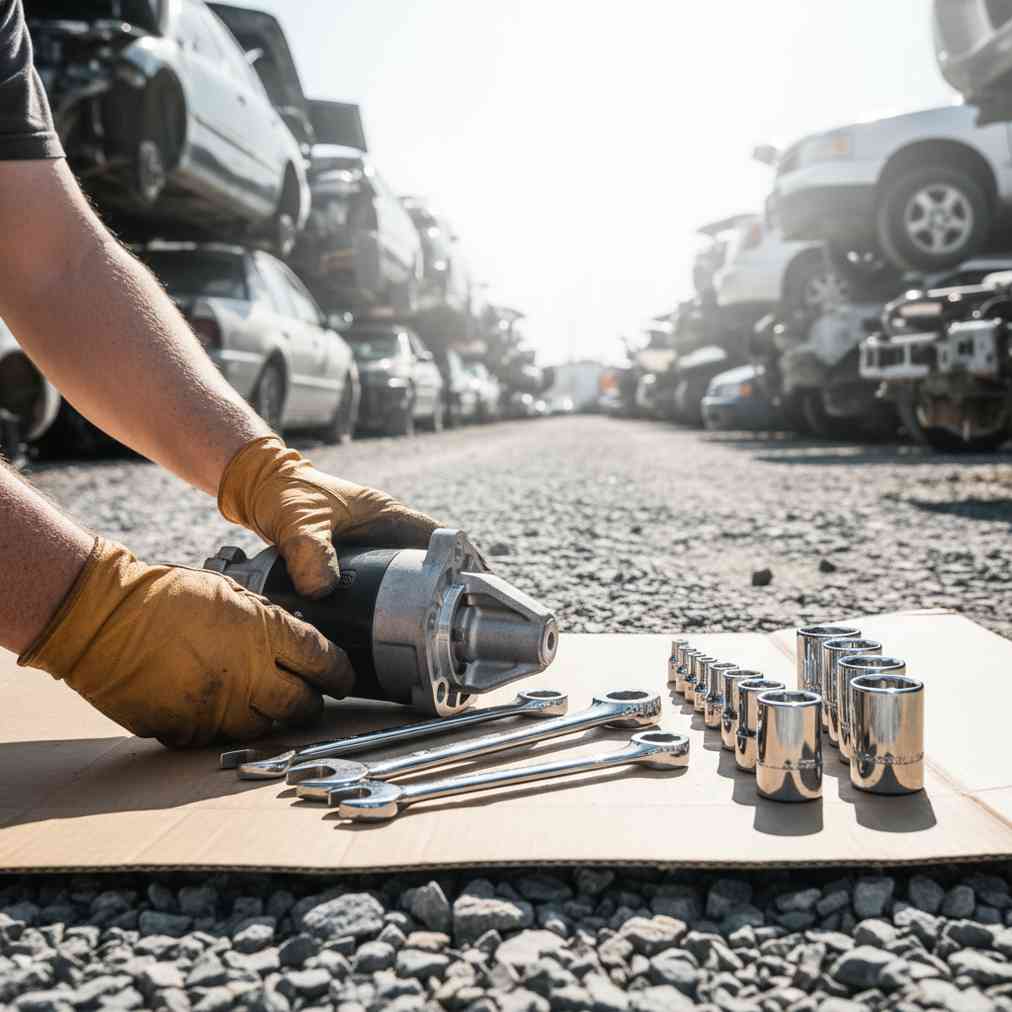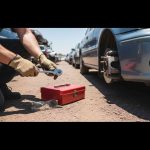Understanding Junkyard Etiquette: The Foundation of Salvage Yard Culture
The world of self-service salvage yards operates on an unspoken code of conduct that ensures safety, fairness, and efficiency for everyone in the DIY automotive community. These unwritten rules of junkyard etiquette have evolved from decades of shared experiences among car enthusiasts, mechanics, and everyday drivers looking to save money on auto repairs. Understanding and following these guidelines isn’t just about being polite—it’s about maintaining the collaborative spirit that makes these automotive treasure hunts possible.
Whether you’re visiting a junkyard near me for the first time or you’re a seasoned parts puller, these etiquette rules form the backbone of the salvage yard experience. They stem from the understanding that vehicles in these yards are shared resources, destined for the crusher, and that everyone deserves a fair chance to find what they need.
The Core Principle: Respect for All
At its heart, junkyard etiquette revolves around one fundamental concept: respect. This encompasses respect for the property, respect for fellow customers (often called “pullers”), respect for the parts themselves, and respect for the staff who maintain these facilities. This principle guides every interaction and decision you make while navigating the rows of vehicles in search of that perfect part.
“The general consensus among seasoned visitors is that it boils down to common sense and not being a selfish tool,” notes one experienced salvage yard customer. “If someone is struggling with a large job, offering simple assistance is appreciated, but bringing your own help for major tasks is considered proper preparation.”
Essential Rules for Working Around Other Customers
The “dibs system” is perhaps the most important aspect of junkyard etiquette when it comes to interacting with fellow parts hunters. These guidelines help prevent conflicts and ensure everyone can work efficiently:
The Sacred Space Rule
- Don’t crowd active workers: If someone is actively working on a vehicle, especially for large or difficult parts like engines or transmissions, avoid starting work on the same vehicle without permission
- Ask before pulling: When you need a part from a car someone else is working on, politely ask if they mind you taking your specific part
- Respect project designations: Some vehicles might be designated as “project cars” or kept whole for specific reasons—never remove parts without clear permission
According to discussions on automotive forums like the Garage Journal, most experienced pullers are willing to take a short break to accommodate others, but approaching with courtesy makes all the difference.
The First-Come, First-Served Principle
- Parts don’t belong to anyone until they’re physically removed from the vehicle
- You cannot “claim” parts by simply marking them or stating your intent
- Arrive early for highly sought-after parts
- Share workspace fairly—yards are community spaces
Preserving Parts for Future Customers
One of the most respected aspects of salvage yard etiquette involves leaving vehicles in good condition for the next customer. This philosophy extends the useful life of parts and maintains the yard’s value for everyone.
| Good Practice | Why It Matters |
|---|---|
| Minimize unnecessary damage | Preserves surrounding parts for other customers |
| Handle wiring carefully | Prevents destruction of entire harnesses for single sensors |
| Close doors and hoods when finished | Protects interiors from weather damage |
| Put unused parts back properly | Makes parts visible and accessible for others |
Proper Part Removal Techniques
- Unbolt rather than cut: Whenever possible, use proper tools to remove parts cleanly rather than cutting or breaking them
- Protect wiring connections: Disconnect proper connectors instead of tearing apart entire wiring harnesses
- Clean up debris: If you break glass or create other hazards, make them visible or clean them up
- Return unused parts: Place parts you ultimately don’t need back on or near the vehicle in visible locations
Resources like Wrench-A-Part’s etiquette guide emphasize that even though cars are headed for the crusher, maintaining parts for the next person is a cornerstone of the community spirit.
Safety and Conduct Guidelines
Safety in salvage yards isn’t just about following posted rules—it’s about protecting yourself and others through responsible behavior that’s become part of the unwritten junkyard code.
Essential Safety Practices
- Wear appropriate protective gear: Closed-toe, sturdy shoes are non-negotiable due to sharp objects and heavy parts
- No prohibited tools: Cutting torches and other dangerous tools are banned due to fire hazards
- Stay sober: Never consume alcohol or work under the influence—coordination is crucial for safety
- Come prepared: Bring your own tools and assistance for heavy items like engines
Professional Conduct Standards
- Honesty at checkout: Bring every part to the counter for pricing, including small items like bolts and clamps
- Respect staff: Treat employees courteously and avoid aggressive haggling over fixed prices
- Environmental responsibility: Properly dispose of fluids and hazardous materials
- Mind your manners: Use courteous behavior, greetings, and gratitude with both staff and fellow customers
Educational content from junkyard safety videos consistently emphasizes that good relationships with staff often lead to helpful tips, better service, and sometimes more flexible pricing.
Modern Junkyard Trends and Technology
Today’s salvage yards are evolving with organized, modern “U-Pull-It” operations that offer enhanced amenities while maintaining traditional etiquette expectations. These improvements include online inventory searches, provided wheelbarrows, and engine hoists, but they also raise the bar for customer preparedness and respect.
Technology Integration
- Online inventory databases help locate specific vehicles before visiting
- Smartphone apps for part identification and compatibility checking
- Digital check-in systems for faster processing
- GPS-enabled yard maps for efficient navigation
Resources like JunkyardsNearMe.net highlight how these technological advances complement rather than replace traditional etiquette principles.
Building Positive Relationships
Following proper junkyard etiquette creates numerous benefits that extend far beyond simple politeness. These advantages compound over time, making regular visits more productive and enjoyable.
| Benefit | How It Helps |
|---|---|
| Staff Recognition | Honest customers often receive priority help and insider tips |
| Community Respect | Fellow pullers may share information about rare parts |
| Enhanced Safety | Collective adherence to practices minimizes hazards for everyone |
| Better Deals | Good relationships can lead to flexible pricing or special arrangements |
Common Etiquette Violations to Avoid
Understanding what not to do is equally important as knowing proper behavior. These common violations can quickly earn you a bad reputation and make future visits less pleasant:
- Tool borrowing without permission: Never use someone else’s tools without explicit permission
- Leaving dangerous messes: Don’t abandon sharp debris or unstable parts that could injure others
- Hoarding behavior: Taking more parts than you need or claiming parts you’re not actively removing
- Ignoring posted rules: Every yard has specific policies—ignoring them affects everyone’s access
- Aggressive negotiation: Prices are typically fixed, and excessive haggling creates tension
Insights from experienced salvage yard communities show that avoiding these behaviors is crucial for maintaining access and positive relationships.
Special Considerations for Different Types of Parts
Different types of auto parts require specific etiquette considerations based on their value, complexity, and safety implications.
High-Value Parts Etiquette
- Engines and transmissions: These require significant time and effort—respect others working on major removals
- Electronic modules: Handle carefully and test thoroughly before checkout
- Catalytic converters: Be aware of legal requirements and proper documentation
Safety-Critical Parts Protocol
- Airbags and safety systems: Follow special handling procedures and inform staff
- Brake parts: Ensure you’re not compromising vehicle stability for others
- Steering parts: Leave vehicles in safe, accessible condition
Seasonal and Weather Considerations
Junkyard etiquette also extends to being considerate of weather conditions and seasonal challenges that affect all visitors:
- Muddy conditions: Be extra careful not to track mud into clean areas
- Hot weather: Share shade when possible and stay hydrated
- Cold weather: Tools become more brittle—exercise extra caution
- Busy seasons: Peak times require extra patience and courtesy
Environmental Responsibility
Modern junkyard etiquette increasingly includes environmental consciousness as salvage yards play a crucial role in automotive recycling:
- Properly contain and dispose of fluids like oil, coolant, and brake fluid
- Separate different types of materials for appropriate recycling
- Report environmental hazards to yard staff immediately
- Support yards that demonstrate strong environmental practices
Information from automotive recycling experts emphasizes that environmental responsibility is becoming a key component of modern salvage yard operations.
The Future of Junkyard Etiquette
As the automotive industry evolves with electric vehicles, advanced electronics, and new materials, junkyard etiquette continues to adapt. Future considerations include:
- Electric vehicle safety: New protocols for high-voltage systems
- Advanced electronics: Increased care needed for sensitive parts
- Sustainability focus: Greater emphasis on environmental responsibility
- Digital integration: Technology-enhanced customer service expectations
Getting Started: Your First Visit
For newcomers to the salvage yard scene, following these etiquette guidelines from day one establishes you as a respectful member of the community. Whether you’re looking for affordable parts to repair your current vehicle or considering selling your old car for cash for cars, understanding and respecting these unwritten rules will enhance your experience and contribute to the positive culture that makes these automotive treasure hunts possible.
Remember that junkyard etiquette isn’t about rigid rules—it’s about common sense, mutual respect, and maintaining the collaborative spirit that has defined the salvage yard community for generations. By following these guidelines, you’re not just getting the parts you need; you’re helping preserve an important aspect of automotive culture that benefits everyone who shares the passion for keeping vehicles running and reducing waste.
The next time you visit a salvage yard, carry these principles with you. Your considerate behavior will be noticed and appreciated by both staff and fellow customers, creating positive relationships that can last for years and countless successful parts-hunting expeditions.





Leave a Reply
You must be logged in to post a comment.